Reach for the Sky
Private companies are competing to bring tourism to outer space.
If you could travel anywhere you wanted this winter, where would you go? Would you ski in the mountains, visit friends or family in another state, or lie on a tropical beach somewhere?
Or would you rather take a rocket into space?
That last choice might not be as far off as you think. A handful of companies are designing rockets, testing engines, and building electronic systems to create spaceships that would take everyday people on the trip of a lifetime.
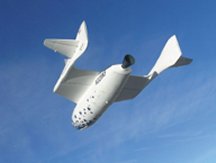 |
|
SpaceShipOne, a privately-built spacecraft, has now flown several times into space. |
| Photo courtesy of Scaled Composites, LLC |
Already, several astronauts have flown into space in a privately-built spaceship. On Sept. 29, Mike Melvill piloted a torpedo-shaped vehicle called SpaceShipOne to an altitude of 64 miles above Earth’s surface.
A plane had towed the spacecraft to 50,000 feet, just above where a jumbo jet flies. Then SpaceShipOne broke away, fired its rocket engine, and soared upwards. The ship rolled 29 times as it was climbing out of the atmosphere, adding some unexpected excitement, but Melvill got things under control and landed safely in California’s Mojave Desert about 24 minutes later.
Five days later, Brian Binnie earned his astronaut wings by flying SpaceShipOne even higher, to an altitude of more than 69 miles.
Until the flights of SpaceShipOne, all astronauts had zoomed into space aboard vehicles built by government agencies, such as the National Aeronautics and Space Administration (NASA).
“I strongly feel that, if we are successful, our program will mark the beginning of a renaissance for manned space flight,” Burt Rutan says. He heads the company, Scaled Composites, that built SpaceShipOne.
“We need affordable space travel to inspire our youth, to let them know that they can experience their dreams, can set significant goals and be in a position to lead all of us to future progress in exploration, discovery, and fun,” Rutan says.
Eyes on the prize
Because SpaceShipOne completed two manned space flights within 2 weeks, Rutan and his team won the $10 million Ansari X Prize.
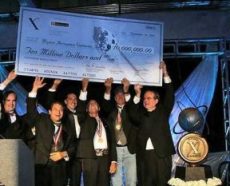 |
|
As winners of the Ansari X Prize, members of the SpaceShipOne team hold up a check for 10 million dollars. The check was presented on Nov. 6, 2004, in St. Louis. |
| Courtesy of the Ansari X Prize Foundation |
The X Prize had been set up by Peter Diamandis, who was first bitten by the space-exploration bug when he was 9 or 10 years old. As a kid, he tracked the Apollo space program and the race to put a man on the moon.
“One of my objectives in getting the X Prize going was to get people excited about space again and create a new race that they can be involved in,” Diamandis says.
In early November, Diamandis handed over a big check to the SpaceShipOne team. “It feels fantastic,” he says. “It feels so good to give away $10 million.”
Still, winning the X Prize is just the first leg in the race for space tourism. Companies have to continue to improve spacecraft to make travel safe and somewhat affordable.
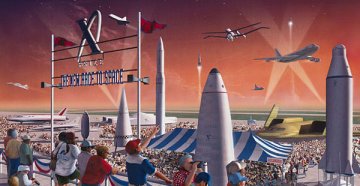 |
|
The X Prize Cup festival will give people a chance to see the latest rocket technology. |
| Courtesy of Ansari X Prize |
Now, instead of having just one X Prize, Diamandis and others are setting up an X Prize Cup competition, a 10-day festival that will be held every year in New Mexico. Visitors to the space fair will get an up-close look at new technology, watch rocket launches, and conduct interactive experiments, among other things.
The competition
Teams from all over the world had been working hard to grab the X Prize. But they aren’t giving up on their space-bound ships just because they didn’t win.
The biggest problem for most of the groups is getting enough money to build and test rockets. Billionaire Paul Allen invested millions of dollars in SpaceShipOne, but most teams don’t have that kind of cash. Still, the engineers and physicists and mathematicians are moving forward with their projects, often volunteering their time.
“I’m just wowed about the idea of exploring in space,” says Eric Meier. He’s with Space Transport Corporation, a company based in Washington state. “I think there’s a lot of challenges out there that will be a lot of fun to tackle,” he says.
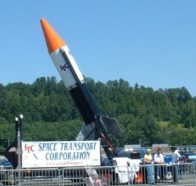 |
|
The Rubicon 2 launch vehicle on display at the Museum of Flight in Seattle, June 2004. |
| Courtesy of Space Transport Corporation |
Meier dreams of one day having a moon base where adventurers could vacation and play basketball or mountain bike. But for now, the Space Transport team is focusing on building the rocket that will carry people into space.
The company tried to launch its unmanned Rubicon 1 rocket in August 2004, but the engine malfunctioned and the craft exploded. “It was pretty spectacular,” Meier says.
The Space Transport team has learned from its mistakes, and it’s now finishing a new and improved Rubicon 2. The group has tried to keep things as simple as possible, but new guidance systems, electronics, engines and a spinning launch pad still need to be tested.
Once everything’s working, Space Transport hopes to get funding for a bigger rocket that can take passengers into space.
Star chaser
Over in England, Steven Bennett’s company, Starchaser Industries, has already tested 16 different rockets. Each one was bigger and better than the one before, Bennett says.
Starchaser’s entry in the tourism space race will have a reusable booster rocket and a three-passenger capsule that detaches in an emergency. The rocket’s engine is the biggest built in the United Kingdom since the government stopped its space program.
“If you’re a speed junkie, our rocket’s for you,” Bennett says.
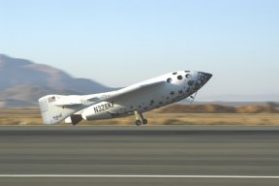 |
|
SpaceShipOne coming in for a landing. |
| Courtesy of Scaled Composites, LLC |
As the Starchaser team works on its newest project, its members are bringing a 40-foot rocket to show-and-tell at schools around England.
“We’re trying to encourage kids to get into science and engineering and technology,” Bennett says. “There’s a kid in 10th or 9th grade now, and he’s going to be the first one to set foot on Mars. It would be really cool if he was inspired by us.”
Big balloons
Other companies in the space tourism business are trying unconventional designs.
Canada’s da Vinci Project, based in Toronto, is putting the finishing touches on a rocket that will be launched from the world’s most massive helium balloon. The team is also using surprising materials, such as treated wood.
Volunteer Chris Vance says that he hopes these new approaches will inspire NASA to be more creative as well.
Volunteers, including enthusiastic students from nearby universities, have done much of the work for the Canadian team.
“People have responded like crazy,” Vance says. “We’ve had guys move out here to help with the project.”
Vance spends a lot of his time scouring the Internet looking for parts. There’s no convenient “rocket store” down the street, he says.
Vacation in orbit
Most companies developing spacecraft have focused on taking people on brief, suborbital flights 62 miles above Earth. Interorbital Systems in California, on the other hand, is jumping one step ahead. This company is developing an orbital spacecraft that would host guests for 7-day vacations at 250 miles above Earth.
 |
|
Interorbital Systems is developing the Solaris X rocket to take passengers into orbit around Earth. |
| Courtesy of Interorbital Systems. Illustration by Andrew Collins. |
“If somebody is interested in really the ultimate adventure, this is it,” says Interorbital Systems co-founder Randa Milliron.
The scientists involved in both orbital and suborbital projects predict that, if all goes well, space tourists could soon be floating weightless, gazing back at the planet.
“I think we’ll see people buying tickets in the next 3 to 5 years,” Diamandis says. The rides won’t be cheap, however. Tickets could start at $200,000 a trip.
Still, who knows? Although you can’t make it this winter, maybe you could celebrate your high school graduation in space. Start saving your pennies now!
Going Deeper:







